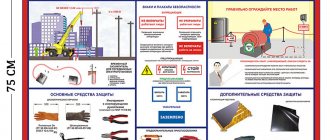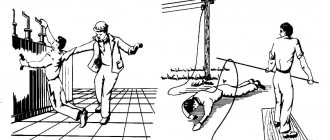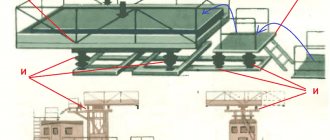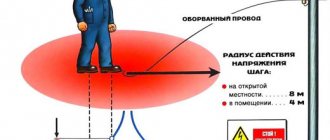Electricity is not fire, but playing with it is no less dangerous
Today, the reader and I will talk about a very important topic, namely, we will discuss the main organizational and technical measures against electric shock. We are all accustomed to taking electricity for granted and sometimes we forget how dangerous it can be for people’s lives, so it would not be superfluous to remind you how to protect yourself and your family from unforeseen situations that may arise in everyday life.
Theoretical introduction
First of all, let's define some terms that will appear frequently throughout our material:
The current-carrying part of the wire is its strands
- Live part is a section of wiring or electrical installation that is energized during operation. Zero working conductor also falls into this category.
- An exposed conductive part is a place in an electrical installation that can be freely touched. Nominally it is not energized, but due to certain circumstances, this element may also become energized, for example, if the insulation is broken.
- Third-party conductive part - equipment that is not part of the electrical installation, but is capable of conducting current.
- Direct touch is contact of a living organism (human or animal) directly with a live part.
- Indirect touch – contact with exposed conductive parts.
- Ultra-low voltage - for alternating current it is no more than 50V, and for direct current - 120V.
- Potential equalization is the connection of conductive parts, leading to equalization of potentials in them.
- Automatic shutdown - opening of one or more phases in automatic mode. Also applicable for the neutral wire.
Now you can go directly to the material.
Sources of Electric Shock
If you touch a source of current, it will pass through you and go into the ground. If you touch both poles of the current with both hands, it will completely pass through you. Of course, the second option is the most dangerous.
Electric shock occurs when touching live parts of electrical equipment. However, oddly enough, most often another scenario occurs when a person touches a metal piece of equipment that should not have been exposed to current due to broken insulation of current-carrying elements and received a certain charge.
You can also get an electric shock if a broken power wire is lying on the ground or during a short circuit in the electrical network.
Basic protection measures
Human ways are also sometimes inscrutable.
Electric shock can occur from both direct and indirect contact with live parts of an electrical installation.
To prevent this from happening, the following measures are applied (individually or as a group):
High-quality wire insulation is very important
- Insulation of live parts;
- Use of fencing and shell;
- Construction of barriers;
- Limiting the access area to a running electrical installation;
- Application, as a working, ultra-low voltage.
This applies to working electrical devices.
In cases of insulation damage, so that indirect contact does not lead to electric shock, the following are used:
The grounding loop must go to a sufficient depth in the ground
- Grounding of the open part of the electrical installation;
- Using various devices to organize automatic power off;
- Equalization and equalization of potentials;
- Organization of double, reinforced insulation;
- Again - the use of ultra-low voltages;
- Separation of electrical networks;
- Arrangement of insulating rooms that serve as a kind of buffer that does not conduct current.
Interesting to know! If the electrical installation is located in the potential equalization zone, then it does not require protection from direct contact. In this case, the maximum operating voltage for alternating current should not exceed 25V in rooms where there is no increased danger, and 6V in all other cases. For direct current these values are 60 and 15 Volts, respectively.
Potential equalization: basic measures of protection against electric shock
Protection against indirect contact is carried out in all cases if the operating voltage does not fall into the ultra-low category. If we are talking about premises with increased danger, then similar measures may be required for lower voltages.
Classification of methods of protection against electric shock
The general conditions for the application of protective measures are described in detail in GOST R 50571.3-94.
Protective grounding
Now let's describe in more detail the main protection measures listed above, and start with the most common one - grounding.
Ground loops
Grounding a device is nothing more than connecting its open part to a grounding device (circuit).
Grounding itself is divided into two types:
- Working grounding – it is also called functional grounding. Points in electrical installations are grounded in order to ensure the operation of the device; a prime example is the neutral of a transformer.
- And protective grounding installed on devices and equipment to ensure safety. It is used in networks where the neutral is isolated or solidly grounded.
As we know, electricity, like water, follows the path of least resistance. Therefore, when touching a device that is energized, the current will flow not through the person, but along an alternative path.
Reference! Dry, clean, and intact human skin has a design resistance of 3,000 to 100,000 ohms, while the resistance of a ground conductor is practically zero.
Paths of electric shock
If you are interested in the numerical values established for protective grounding, then refer to the text of the PUE, 7th edition - it is selected depending on the neutral mode, resistance (specific) for the soil and voltage level.
For groundings, resistance measurements are performed immediately after installation or after major repairs, only on the driest days, which include: frosty in winter, hot in summer. At the same time, touch voltage is measured. This procedure is performed once every 6 years.
Ideally, each grounding device put into operation should have a passport that indicates:
- Device diagram;
- Date of the last verification and its results;
- Technical data;
- The nature of the repairs made and changes made.
Protective grounding
Zeroing circuit when touched
Organizational measures to protect against electric shock can be carried out in the form of grounding devices. This is a deliberate connection of open parts of devices with the neutral of the power source itself, also performed for safety reasons. The diagram above shows a schematic diagram of such a connection.
The essence of the connection is to turn any current leakage when touching the electrical installation body into a single-phase short circuit. As a result, the current increases to a sufficient value for the autonomous protection device to operate, which will automatically turn off the power supply - open the circuit in the phase.
Protective measures against electric shock
In other words, the fundamental difference between such a scheme and protective grounding is to reduce the time during which a person can be shocked. We all know that current in a circuit flows at an enormous speed of light, so the response time of protective equipment is measured in tenths of seconds.
For automatic phase disconnection in circuits up to 1 kV, fuses and special switches are used.
Interesting to know! Reliable operation of the fuse occurs when the current in the circuit exceeds its rated value by 3 times, so making these elements with your own hands is strictly prohibited. The cost of saving is small, but the risk...
Potential equalization
Measures to protect against electric shock - potential equalization
The connection diagram of conductors during equalization implies achieving equal potential.
- If anyone doesn’t know, voltage is the potential difference at the ends of a conductor. If there is no difference, then no current will flow.
- In other words, the purpose of such a connection is to make the environment in which a person moves free from the formation of potential differences - all conductive parts of electrical installations and non-electrical equipment located in the room (water pipes, heating pipes, etc.) are connected to each other.
- As a result, if a breakdown occurs on the body of an electrical device, then all potential conductors included in the circuit are under the same voltage.
Recommendations for selection
Dielectric gloves must be of such a size that they can be worn over cotton or wool work gloves. The length of gloves must be at least 35 cm.
Requirements for safety glasses : the glasses must have the properties of not shattering; it is better to choose a closed frame.
Protective boots and galoshes should differ from household ones in the absence of varnishing and the presence of special identification marks.
The minimum length of the insulating track is 75 cm, the dimensions of the mat are at least 50 cm on each side. The surface must be corrugated.
When purchasing voltage indicators, you should carefully monitor compliance with operating conditions: some indicators can only operate at a maximum voltage of 500 V. The installation tool must have insulating handles at least 10 cm long.
It is not advisable to use current clamps for outdoor work . Especially in wet weather. It is advisable to monitor the types of clamps designed for low voltage (up to 1000 V) and higher voltage tools.
Protective equipment
It is clear that protection circuits cannot function without the necessary equipment.
Automatic RCD
In the photo - residual current device
The most effective and widespread protective devices are automatic shutdown circuit breakers - RCDs. The undeniable advantage of these devices includes not only the possibility of protection when a person touches the open parts of the device (case), but also when touching live parts.
- Harsh statistics on electrical injuries show that the overwhelming number of cases of electric shock to a person occurs precisely during contact with live parts, because insulation fails quite rarely.
- That is why the use of RCDs is considered a prerequisite for ensuring sufficient user safety.
- The operating principle of such units is to constantly monitor a certain input value, which is compared with the nominal value. In case of deviations, the circuit is immediately disconnected.
RCD diagram
- RCDs differ from each other in efficiency, which is measured by the time it takes for the protection to operate. Shutdown usually occurs after 0.06-0.13 seconds. The response speed depends on the design of the sensor and transducer.
- Magnetic starters, contactors and circuit breakers are used as executive bodies of such devices.
- The electrical parameter that allows the equipment to conclude that an electric shock has occurred is called the RCD input signal - the current strength in the circuit is most often analyzed.
- The safest equipment is configured in such a way that the device is triggered when the input signal is equal to the largest permissible current that passes through the human body.
The PUE clearly describes all the requirements that relate to the use of RCDs:
- RCDs that react to differential current, to group lines for power supply of outlet networks located on the street and in high-risk premises, are required to be installed. For example, an RCD that responds to a differential current of no more than 30 mA is installed on sockets in the bathroom, located 0.6 meters away from the shower area.
- An RCD is also installed when the existing automation (plugs) is not able to open the circuit faster than in 0.4 seconds in 220V networks due to low current values and if there are no potential equalization systems.
- These devices are also installed on mobile electrical installations that receive power from stationary sources. In addition, they have protection in the form of device overcurrent protection.
- RCDs are installed on electrical installations receiving power from a network with a solidly grounded neutral, with protective grounding of open parts that are not connected to the neutral. In this case, the device is selected taking into account the potential of the electrical installation body compared to the ground.
- Residual current devices cannot be used in three-phase networks in which the neutral is one common conductor.
RCD check
RCDs must be checked periodically. The timing of this is usually determined by the manufacturer's instructions, but this period cannot exceed one quarter. For an RCD connected to the network, the test is performed by pressing the “test” button or simply “t”.
Advice! If a malfunction is detected, the operation of electrical equipment that does not have other degrees of protection is prohibited.
Other protection means for networks up to 1000V
Not all collective electrical shock protection measures are equipment in the circuit. These devices are usually divided into basic and additional.
The first category includes:
Insulating rod
- An insulating rod is equipment that can be used to touch electrical installations during operation. Their body is made of high-quality dielectric, depending on the type of which, these devices can be used in installations up to 550 kV.
Current clamps
- Current and insulating clamps - designed to replace fuses in installations operating under voltages up to 1000V, or to measure current in a circuit. Used in conjunction with dielectric gloves and safety glasses.
Testboy Profy tester
- Voltage indicators or in other words testers. Used to check the current voltage in the electrical network.
Insulated tool
- Insulated tool and dielectric gloves. Everything here is extremely clear; it is only worth mentioning that an insulated tool includes any mounting devices with handles coated with a layer of dielectric, which are used during installation and repair work in electrical installations.
Additional protective measures are distinguished by the fact that they are not able to protect against electric shock on their own, and can only be used in conjunction with the main ones. They serve to protect step and touch.
These include:
Rubber galoshes
- Dielectric galoshes;
Rubber mat
- Dielectric carpets;
Rubber pads
- Dielectric supports and pads of various configurations;
Caps
- Insulating caps.
But that’s not all. Also, when working with electrical installations, it is sometimes necessary to use personal protective equipment in the form of helmets, goggles and shields, respirators and gas masks, gloves and fall arresters.
Timely provision of personnel with all protective equipment, as well as their proper condition, is the key to safe work.
Basic safety measures
Carrying out electrical repair work requires great care and responsibility.
Personal protective equipment against electric shock
To avoid unexpected or indirect human contact with live parts, it is necessary to provide basic measures of protection against electric shock. These include:
- Mandatory presence of solid insulation that prevents direct contact with exposed elements of electrical conductors;
- A restrictive barrier for unauthorized persons to access electrical power equipment and electrical installations. The protective fence must be durable and equipped with locking elements and combination locks;
- To avoid physical contact during inspection, it is necessary to install live parts at a considerable distance from each other;
- Use of lighting devices operating at low voltage from 12 to 36 W for electrical lighting of power electrical installations. The same voltage is recommended for the electric drive of the necessary power tools. For this purpose, step-down transformers are used with their secondary winding grounded.
In addition to the main list of protective safety measures, in order to avoid electric shock to a person, an electrical potential equalization system and an automatic shutdown device (RCD) are used.
Automatic shutdown device (RCD)
First aid for electric shocks
Hidden danger
It happens that, despite all precautions, electric shocks still occur. Depending on the current voltage and current, the effects can vary, ranging from simply discomfort to death.
Sometimes, timely actions can save a person’s life, so let’s talk a little about how first aid is provided in case of electric shock.
Basic Rules
What to do in case of electric shock
The first thing you need to remember is that you cannot touch the person who is being shocked with your bare hands, otherwise he will start beating you too.
- We care about our safety. In order to remove the wire from the victim, you need to wear gloves - preferably rubber, but if they are not available, any dry ones. Current can also flow through the floor, so be sure to wear shoes or stand on a dielectric surface.
- Now we remove the wire from the victim and drag him to the side at least 10 meters. It is imperative to drag by the clothes so as not to accidentally cause injury.
- We call an ambulance.
- We feel the pulse through the carotid artery passing in the neck. It is more difficult to determine it from the wrist, since the vessels there are smaller, and even if you are still wearing gloves, you may simply not hear it.
Checking pupil reaction
- If the victim has lost consciousness, then it is necessary to check the reaction of his pupils to light. The upper eyelid is lifted, after which it is checked whether the diameter of the pupil changes. If there is little light around, you will need a flashlight.
- You can also check for breathing.
- If there is no pulse or breathing, and the pupil has a large diameter and does not react to light, then the victim has experienced clinical death. It is urgent to carry out resuscitation cardiopulmonary measures (indirect cardiac massage and artificial respiration).
- If consciousness has not left a person, then he needs to be given a lying position on his side and covered with a blanket or jacket on top to keep him warm.
- The victim should not be left alone, as his condition may worsen at any moment. We are waiting for the doctor to arrive, who will decide what to do next.
Interesting to know! After successful resuscitation, cases of repeated cardiac arrest are common, so the victim’s condition must be constantly monitored.
Remember that providing first aid to a victim is quite a shocking moment, so control yourself and don’t think about anything else other than the fact that you can save someone else’s life. Emotions need to be put aside for later.
Doctors on call
Only a professionally trained doctor can give an accurate assessment of the victim’s condition, but you can also understand the extent of the person’s damage based on the signs described.
How to free a person from wires
How to remove a person from a live wire
The peculiarity of an electric shock to a person is that if he holds the conductor with his hands, involuntary muscle contraction occurs, which makes it very difficult to remove the wire, and the person continues to be shaken and beaten. You will not be able to help him until you de-energize the conductor or eliminate the contact.
- The most optimal solution would be to turn off the current in the entire circuit if there is a corresponding switch or breaker nearby.
- Otherwise, you will definitely need third-party equipment: gloves or a dry board.
- If the victim has a strong grip on the wires, you can cut them with an ax and hold them by the wooden handle.
If an electric shock occurs at a height, then it is additionally necessary to take into account the possibility of a person falling.
Maintenance of vital functions
These actions include all resuscitation measures, as well as the following:
- If, when you touch, you feel that the person is cold, then you need to cover him, with the exception of places with burns, as this will significantly increase the pain effect.
- The person needs to be given the most comfortable position.
- If there are secondary injuries with bleeding on the face, then they need to be stopped. It is important to remember here that during venous bleeding, the blood is pushed out in spurts, and it has a dark tint. In this case, a tourniquet is applied directly to the site of the outbreak. It is typical for arterial bleeding that the blood comes out in a stream and has a bright red, scarlet tint - a tourniquet is applied slightly above the wound.
- If a person has fractures, then a splint should be applied to the limb; any flat, hard object will do.
- If a person falls, he or she may suffer a spinal injury. In this case, it is not recommended to move it again.
- There is no point in trying to reduce dislocations, as you can only cause harm.
What not to do
Additional Information
It is equally important not to forget about what is prohibited from doing while providing assistance:
- Firstly , touch live people and wires with your bare hands so as not to get hit yourself.
- Secondly , the victim should not be placed in a sitting position, even if he is conscious.
- Thirdly , do not try to treat thermal burns with ointments or any folk remedies.
- Fourthly , do not give the victim any medicine, even if you know what is needed. Doctors who arrive may repeat the appointment, which could result in an overdose.
- And fifthly , do not leave the victim, even if there are no signs of life. Carry out resuscitation measures until doctors arrive, since the supply of blood and oxygen to the tissues will not stop.
Let’s end the article on this not entirely positive note. Safety precautions and first aid in case of electric shock are the knowledge that will not be superfluous. You never know what could happen next to you in the next minute. If you want to understand in more detail the rules of first aid for electric shocks, then watch the attached video.
Basic and additional means of protection against electric current
The insulation of the basic protective equipment can withstand the operating voltage and can touch live parts. The insulation of additional protective equipment is not designed for operating voltage and is used as an additional protective measure to the main protective equipment.
| Means of protection | Up to 1kV | Above 1kV |
| Basic |
|
|
| Additional |
|
|
In addition to those described above, there are fencing and safety protective equipment. Fencing: shields, insulating pads, portable grounding and warning posters.
Safety: helmets, goggles, mittens, gas masks, claws, safety ropes, assembly belts. And to protect against ultra-high voltage electric fields (arcs), portable shielding devices are used - screens.
Dielectric gloves
in installations up to 1 kV they are used as the main protective device, and in installations above 1 kV - as an additional one. You should ensure that there are no tears in the glove, for example by inflating it and seeing if air comes out. They also naturally must be tested like other PPE and have a seal.
Dielectric carpets and galoshes
protect against step voltage and are additional PPE.
Isolation stands
serve not only as the main means of access for short relay operators to the relay compartments of cells in RU-6kV, but also as an additional means of protection against electric shock.
Insulating rods
depending on the voltage class they have different lengths. They consist of three parts: handle, working part and insulated part.
| Rated voltage of the electrical installation, kV | Minimum length of insulating part, m | Minimum handle length, m |
| up to 1kV | not standardized | not standardized |
| 2-15 | 0,7 | 0,3 |
| 15-35 | 1,1 | 0,4 |
| 35-110 | 1,4 | 0,6 |
| 150 | 2,0 | 0,8 |
| 220 | 2,5 | 0,8 |
| 330 | 3,0 | 0,8 |
| 400, 500 | 4,0 | 1,0 |
Portable grounding
installed when working on switched off equipment to protect personnel from the consequences of possible switching on of the equipment.
And here are the actual groundings themselves:
Insulating and electrical clamps
created for different purposes.
Fuses are removed as insulating fuses, for example under load.
Electrical meters measure various quantities, for example, current clamps measure the amount of current. And current measurements are made without breaking the wires directly on the operating equipment.
Well, the posters. They are different: prohibiting, allowing - almost like in traffic regulations.
Latest articles
Most popular










